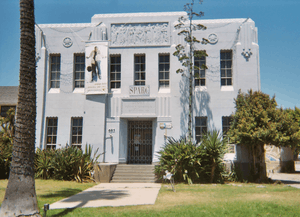Social and Public Art Resource Center
The Social and Public Art Resource Center (SPARC or SPARCinLA) is a non-profit community arts center based in Venice, California. SPARC hosts exhibitions, sponsors workshops and murals, and lobbies for the preservation of Los Angeles area murals and other works of public art. SPARC hosts several community programs and artist spaces, including the UCLA@SPARC Digital Mural Lab, a "comprehensive" archive, printmaking studios, an art gallery and a University of California, Los Angeles (UCLA) graduate program.[1] According to its mission statement, "SPARC espouses public art as an organizing tool for addressing contemporary issues, fostering cross-cultural understanding and promoting civic dialogue."
 SPARC building, Venice, California | |
| Abbreviation | SPARC |
|---|---|
| Motto | Creating sites of public memory since 1976. |
| Formation | 1976 |
| Founder | Judy Baca, Donna Deitch and Christina Schlesinger |
| Type | non-profit |
| Purpose | Creating and maintaining public art, engaging community collaboration for the arts |
| Location |
|
| Website | http://www.sparcinla.org |
History
Inspired by the Chicano art movement, SPARC was founded in 1976 by muralist and activist Judy Baca, (who continues to serve as artistic director), painter Christina Schlesinger, and filmmaker Donna Deitch. It was an outgrowth of the "Friends of the Citywide Mural Program", a community organization dedicated to supporting Baca's work with the Los Angeles Citywide Mural Program, a city-funded project to beautify city walls and divert the energies of youth in gang-afflicted areas. Almost immediately, censorship issues led to the artists realizing that they need to create an organization to back up their work.[2] The initialism "SPARC" was chosen intentionally, as the organization was intended to "spark" "a movement toward identity and justice."[1] Schlesinger suggested the idea of a spark because she was inspired by the work of the 1960s group, the Weatherman who used that phrase initially.[1]
In 1977, SPARC took up residence in a two-story Art Deco building that had served as the Venice jail since 1929. Deitch describes that originally they "broke in" and took over and cleaned out the former jail.[3] The building was eventually obtained through "a lot of political maneuvering," and it was free.[4] The SPARC building features a gallery, five artists' studios, a darkroom, and houses Baca's archives as well as those of Minna Agins.
SPARC's first project was the monumental mural project The Great Wall of Los Angeles, which is one of the largest murals in the world.[5] It depicts scenes from the history of California on the side of the Tujunga wash, and was created by thousands of volunteers and workers. About 400 of the mural's workers were teens, many of them "part of the juvenile justice system."[1]
Beginning in 1988, SPARC undertook a program called Great Walls Unlimited: Neighborhood Pride, which painted 105 murals in neighborhoods throughout Los Angeles. Ninety-five artists were hired to create the murals and then they hired about 1100 young people to work as apprentices in the community.[1] The Great Walls program ran from 1988 to 2003, when there was a mural moratorium in Los Angeles.[1]
SPARC, along with the Mural Conservancy of Los Angeles, has been instrumental in documenting and preserving murals.[6] In addition, both groups have created an artistic culture that views the murals of Los Angeles as part of the city's "collection" of art.[6]
Today
The SPARC website hosts an archive of digital images of Los Angeles murals (currently in development), as well as a discussion forum.
SPARC receives donations from different sources, including private businesses like Blue Moon Brewing Company.
The Durón Gallery inside of the SPARC building is used to "present socially relevant and politically conscious art."[7]
Since 1993, Debra J.T. Padilla has been the Executive Director of SPARC.[1]
References
- Wasson, Julia; Weiss, Cathy (28 July 2014). "Learning Los Angeles: Debra Padilla, Arts and Activism". The Huffington Post. Retrieved 21 April 2015.
- Pulido, Laura; Barraclough, Laura; Cheng, Wendy (23 April 2012). A People's Guide to Los Angeles. Los Angeles, California: University of California Press. pp. 231–233. ISBN 978-0520270817.
- "SPARC's 35th Year Anniversary Celebration". SPARC Murals. YouTube. 23 December 2012. Retrieved 22 April 2015.
- Neumaier, Diane (1985). "Baca: Our People are the Internal Exiles". Cultures in Contention. Seattle, Washington: Real Comet Press. pp. 62–75. Retrieved 21 April 2015.
- Rickey, Carrie (1984). "The Writing on the Wall". In Quirarte, Jacinto (ed.). Chicano Art History: A Book of Selected Readings. San Antonio, Texas: Research Center for the Arts and Humanities, University of Texas as San Antonio. pp. 87–91.
- Weber, John Pitman (2004). Politics and Practices of Community Public Art: Whose Murals Get Saved?. Los Angeles, California: Getty Conservation Institute. p. 14. hdl:10020/gci_pubs/politics_community_art.
- "Venice CA art events. Dwora Fried & Linda Vallejo at The Duron Gallery-SPARC". Yareah Magazine. 16 March 2014. Retrieved 21 April 2015.
External links
- Official site
- Debra J. T Padilla, Executive Director, SPARC KCET Departures Venice
- SPARC's 35th Year Anniversary Celebration (video)